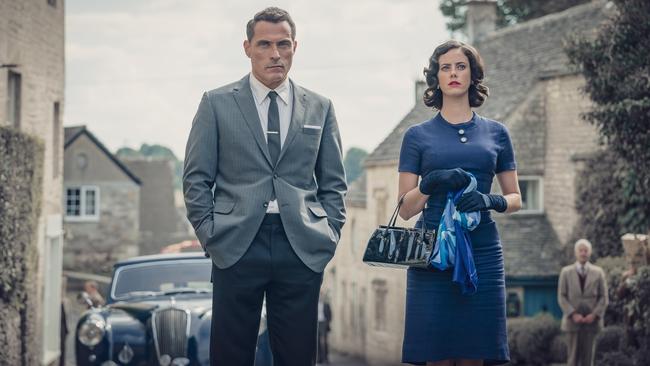‘Cosy Christie’, with an unconventional twist
The Pale Horse gets darker as writer Sarah Phelps and director Leonora Lonsdale crank up the creeping dread.

The Pale Horse is the fifth Agatha Christie adaptation from the BBC and writer Sarah Phelps, and it seems the last as Phelps appears to have accomplished what she set out to achieve in this breathtaking series of reimaginings. If you have followed them since And Then There Were None, that piece of enthralling psychological suspense so cleverly mixed with the baroque ingenuity of the drawing room mystery, you’ll know not to expect a linear reworking of Christie’s novel, first published in 1961.
This is not what Phelps does, so fans of the book be warned. She has pulled apart the novel in her usual fashion and dispersed the parts, only to put them back together with her own additions and abandoning, she argues, little of Christie’s intent. But The Pale Horse — the title is taken from Revelations where it is ridden by Death — is the Christie text with which, she says, she has taken the “most liberties”.
Critics of Phelps’s highly original approach will be dismayed once again, but the writer says she loves the darkness of Christie’s stories, that quality PD James called “the catharsis of terror, the bringing of order out of disorder”, and she delights in taking “this general perception of knowing where you are with ‘cosy Christie’ and twisting it”.
Cosy Christie is characterised by an almost abstract emphasis on the twists and turns of mystification, her skilful deductive legerdemain focused on clues and circumstances rather than character or the complexities of human motive.
She is mistress of conventions: least likely persons, red herrings and suspects who eventually will be cleared. The argument persisted that while Christie’s characters interest the reader, their involvement with them is not deep enough for them to care more about the individual than the plot.
“Christie is certainly a kind of genius, but one cannot help feeling she would have been better off employed in Bletchley Park as a code-breaker, or working for a manufacturer of board games,” John Banville, who writes crime novels as Benjamin Black, suggested recently. “Her plots, while highly ingenious, are also wildly improbable, if for no other reason than that the characters who drive them are not characters at all but marionettes, jerking lifelessly on the ends of their all too visible strings.”
It doesn’t really matter — Christie so cleverly combines complex detection with a highly functional approach to character and atmosphere to beguile millions of readers every year who enjoy her puzzles.
But Phelps likes digging deeper into Christie’s stories, not really interested in the pleasure the narratives of mystification offer but searching for a darker subtext, what she terms “an undercurrent of a very different story”. She says in an interview with entertainment industry site Deadline that in reading the novel she was aware of a tension between the book Christie wanted people to read and the one she really wanted to write. “What she is really writing about is power and how people lie to hold on to their power. It’s not so much the murder, it’s the lying. It’s not what weapon was used, it’s why is that person dead? That’s what I pursue,” Phelps says.
Set largely in the year Christie wrote her novel, Phelps reminds us in her drama through newspaper headlines that it’s the time of the Adolf Eichmann trial, the escalation of the Cold War and Vietnam; change is coming but it has not quite hit London yet.
The so-called sexual revolution, that carnival of subversion, is gorgeously hinted at in sequences set in Soho’s red-light district, where every other entrance seemed to be a striptease revue, massage parlour, sex cinema or sex shop selling magazines and 8mm home movies. A stylised montage sets a kind of occult context for what follows at the start of the drama.
It’s 1960, in the tiny rustic village of Much Deeping. A handsome classy woman asks three formidable ladies a nervous question: Will she make her husband happy? The three women, intense and seemingly capable of summoning visitations from the dead, played with obvious enjoyment by Rita Tushingham, Sheila Atim and Kiera Clarke, stare back at her. It’s obviously a palm reading session with a hint of the supernatural in the way it’s shot. (Christie’s novel on publication drew comparisons with Dennis Wheatley’s bestselling books of the time featuring black magic.)
We next see the woman being electrocuted in her bath after carrying a lamp on a long cord into the luxurious bathroom. We abruptly find her husband, Mark Easterbrook (played with a clenched intensity by Rufus Sewell), deep in grief beside her coffin, then somewhat inexplicitly uncrating a huge stuffed white bear a year later — there’s an abrupt time jump here. (The bear a hint of other worlds, perhaps, of the wilderness now interred in formaldehyde, a suggestion of the weirdness to come that will unsettle the natural order of things?)
Another woman, Jessica Davis (Madeleine Bowyer), also visits the three scary village women. “I have an appointment,” she says, hesitantly. We see her then as she awakes in her rented room and tufts of her hair start to fall out. She dies in the street, staggering towards a police station. She is found to have a list of names hidden in her shoe and to have worked for the three women. One of the names is that of the rich and successful Easterbrook, who now has a new wife, the edgy, high-maintenance Hermia (Kaya Scodelario), and an equally gorgeous new girlfriend, the wanton socialite Thomasina Tuckerton, now working as a nightclub hostess. After spending the evening with her, he discovers Tommy, as she’s known, dead in the bed, a rat in the sink of her room and strands of her hair on the pillow.
The sense of doom is already thick, anxiety and dread hanging over the moment, and we are only five minutes into Phelps’s drama. It quickly turns out that Tuckerton is one of the names on the list, along with Ardingly, a moniker well-known to Easterbrook. He is soon involved in the investigation of Davis’s death led by the doughty Detective Inspector Lejeune (Sean Pertwee) into the mystery of the names in the shoe, the body of his girlfriend still undiscovered and slowly decomposing. His involvement is under increasing suspicion by the police and things become more complicated when he is visited by Davis’s boss, Zachariah Osborne (Bertie Carvel), who is certain that the three women in Much Deeping are involved. “They pretend it’s just herbs and fortunes and seances but it’s the Devil’s work to do in East Deeping,” he tells him. “They kill to order, for money; they do it with curses and craft and hexes — they raise demons and people die.”
But Easterbrook, a rational man, perfect embodiment of male entitlement, will have none of it. For him it’s only “sleight of hand, levers and pulleys and puffs of smoke, people wanting to believe because they’re credulous morons”. And even though, despite his seeming well-tailored composure, he is mentally preoccupied, with paranoia, guilt and complicity that is consuming him, he’s determined to expose this trick.
It’s very clever and absorbing, and leaves us a little uncomfortably uncertain of Easterbrook and whether we can really sympathise with him as the hero of this macabre and often witty tale. As the narrative unfolds we’re left with this notion that we might be tracking the process of the leading character towards his own murder, to which he unconsciously assents. But being both Christie and Phelps, this is probably not the case.
The series is superbly directed by Leonora Lonsdale, her first TV series after a career in short films and commercials, and her advertising background reveals itself in the attention paid to lighting and the way she moves the camera and adjusts the framing during the shot, and the emphasis she places on immersing viewers in a heightened sensory experience.
At times there’s an almost expressionist feel to Lonsdale’s technique, developed, she says, by the way horror can be hiding in plain sight. “We had the idea that the camera would be like death, so you build this sense of creeping dread and the camera sneaks up on them,” she says of her approach to Phelps’s characters. She was also influenced by “these kind of very dark, psychological films of the 60s — Repulsion, Belle de Jour and Rosemary’s Baby — where you have all these beautiful actresses and beautiful apartments, but the secrets are kind of festering underneath”.
The Pale Horse completes Phelps’s quintet of Christies in which the writer wanted to provide a kind of snapshot of 50 years of the 20th century through the great crime writer’s imagination. She told website Denofgeek: “I thought maybe there would be a way to tell a story about 50 years of the blood-soaked and tumultuous 20th century via the medium of murder mysteries from a writer who maybe didn’t invent it but certainly made the genre her own.”
It’s some achievement.
The Pale Horse, Saturday June 20, 8.15pm, ABC.
READ MORE: Warwick Thornton’s solo journey The Beach | Creative talent behind Rake brings Operation Buffalo


To join the conversation, please log in. Don't have an account? Register
Join the conversation, you are commenting as Logout